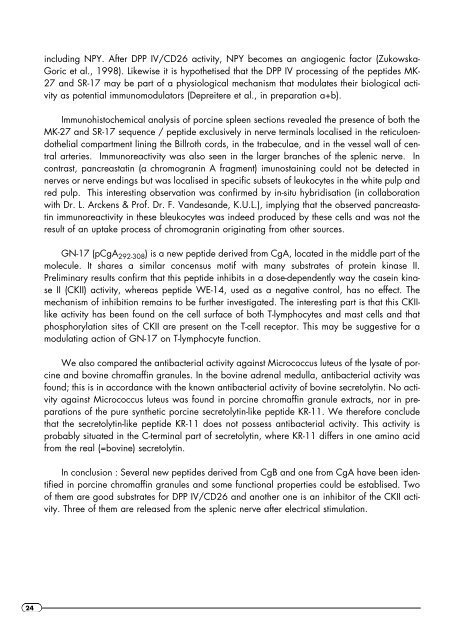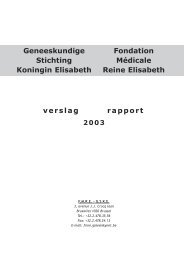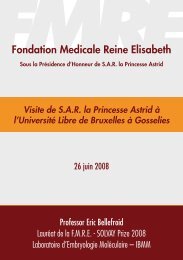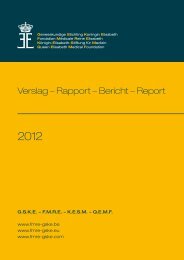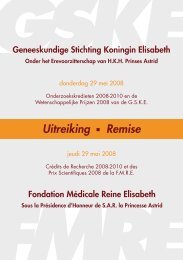Geneeskundige Stichting Koningin Elisabeth ... - GSKE - FMRE
Geneeskundige Stichting Koningin Elisabeth ... - GSKE - FMRE
Geneeskundige Stichting Koningin Elisabeth ... - GSKE - FMRE
You also want an ePaper? Increase the reach of your titles
YUMPU automatically turns print PDFs into web optimized ePapers that Google loves.
24<br />
including NPY. After DPP IV/CD26 activity, NPY becomes an angiogenic factor (Zukowska-<br />
Goric et al., 1998). Likewise it is hypothetised that the DPP IV processing of the peptides MK-<br />
27 and SR-17 may be part of a physiological mechanism that modulates their biological activity<br />
as potential immunomodulators (Depreitere et al., in preparation a+b).<br />
Immunohistochemical analysis of porcine spleen sections revealed the presence of both the<br />
MK-27 and SR-17 sequence / peptide exclusively in nerve terminals localised in the reticuloendothelial<br />
compartment lining the Billroth cords, in the trabeculae, and in the vessel wall of central<br />
arteries. Immunoreactivity was also seen in the larger branches of the splenic nerve. In<br />
contrast, pancreastatin (a chromogranin A fragment) imunostaining could not be detected in<br />
nerves or nerve endings but was localised in specific subsets of leukocytes in the white pulp and<br />
red pulp. This interesting observation was confirmed by in-situ hybridisation (in collaboration<br />
with Dr. L. Arckens & Prof. Dr. F. Vandesande, K.U.L.), implying that the observed pancreastatin<br />
immunoreactivity in these bleukocytes was indeed produced by these cells and was not the<br />
result of an uptake process of chromogranin originating from other sources.<br />
GN-17 (pCgA 292-308) is a new peptide derived from CgA, located in the middle part of the<br />
molecule. It shares a similar concensus motif with many substrates of protein kinase II.<br />
Preliminary results confirm that this peptide inhibits in a dose-dependently way the casein kinase<br />
II (CKII) activity, whereas peptide WE-14, used as a negative control, has no effect. The<br />
mechanism of inhibition remains to be further investigated. The interesting part is that this CKIIlike<br />
activity has been found on the cell surface of both T-lymphocytes and mast cells and that<br />
phosphorylation sites of CKII are present on the T-cell receptor. This may be suggestive for a<br />
modulating action of GN-17 on T-lymphocyte function.<br />
We also compared the antibacterial activity against Micrococcus luteus of the lysate of porcine<br />
and bovine chromaffin granules. In the bovine adrenal medulla, antibacterial activity was<br />
found; this is in accordance with the known antibacterial activity of bovine secretolytin. No activity<br />
against Micrococcus luteus was found in porcine chromaffin granule extracts, nor in preparations<br />
of the pure synthetic porcine secretolytin-like peptide KR-11. We therefore conclude<br />
that the secretolytin-like peptide KR-11 does not possess antibacterial activity. This activity is<br />
probably situated in the C-terminal part of secretolytin, where KR-11 differs in one amino acid<br />
from the real (=bovine) secretolytin.<br />
In conclusion : Several new peptides derived from CgB and one from CgA have been identified<br />
in porcine chromaffin granules and some functional properties could be establised. Two<br />
of them are good substrates for DPP IV/CD26 and another one is an inhibitor of the CKII activity.<br />
Three of them are released from the splenic nerve after electrical stimulation.


